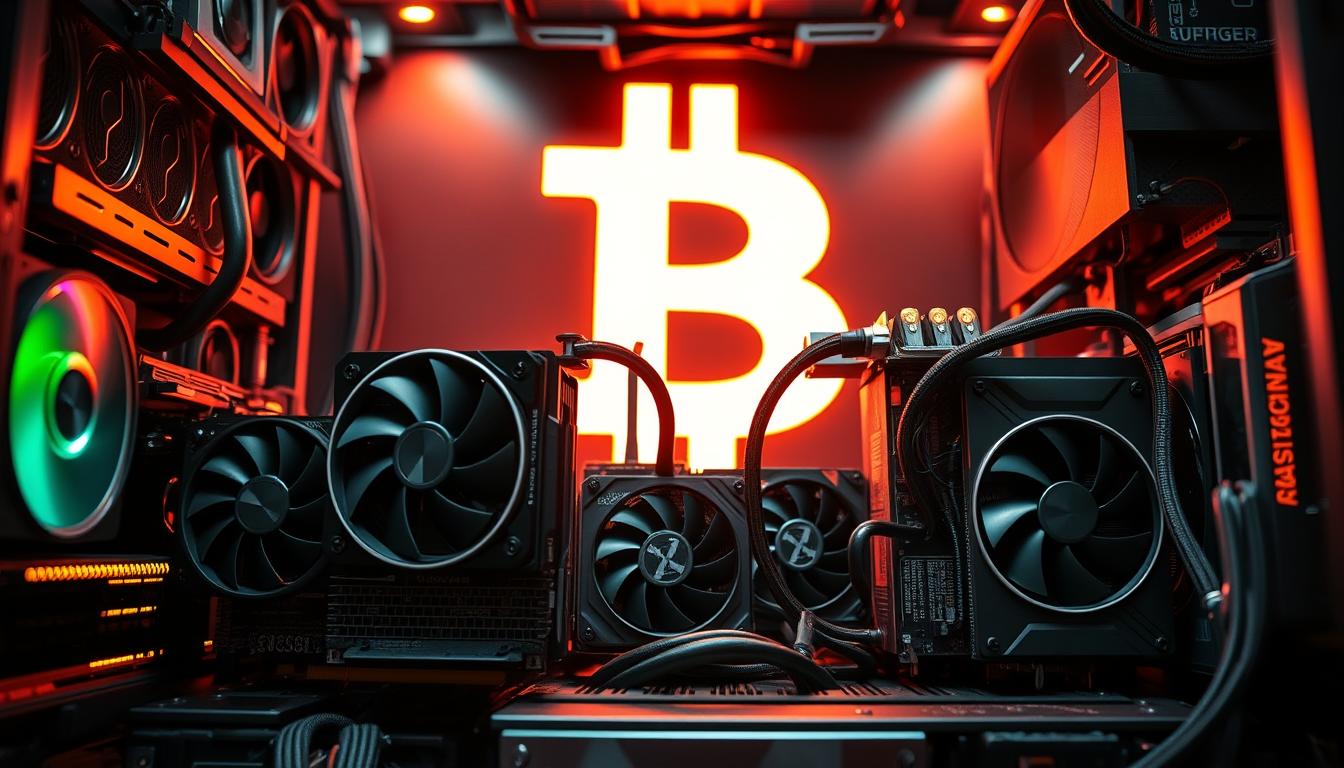Now Reading: Crypto Mining Profitability: Calculate and Maximize
- 01
Crypto Mining Profitability: Calculate and Maximize
Crypto Mining Profitability: Calculate and Maximize
The digital gold rush continues as blockchain networks process billions in transactions daily. With Bitcoin miners generating $20 million in daily revenue, this sector now represents a $600 million monthly market. However, the landscape has shifted dramatically since the early days of home-based operations.

Modern equipment costs range from $2,000 to $20,000, creating significant barriers for casual participants. Professional operations dominate through industrial-scale efficiency and access to cheap electricity. Those who mined blocks in 2010 and held their rewards now see valuations approaching $5 million per block mined.
Three critical factors determine success in this field: block reward structures, computational power efficiency, and network difficulty adjustments. Understanding these elements separates profitable operations from money-losing ventures. While competition intensifies yearly, strategic miners continue finding opportunities through technological innovation and market timing.
This guide breaks down the essential calculations and strategies for navigating today’s complex environment. We’ll analyze real-world examples of operations maintaining profitability despite rising energy costs and equipment expenses. The following sections provide actionable frameworks for evaluating potential returns and optimizing existing setups.
Key Takeaways
- Professional mining operations generate $600 million monthly
- Equipment costs create high entry barriers for individuals
- Early BTC adopters now hold multi-million dollar assets
- Success requires mastering three technical concepts
- Strategic optimization enables continued profitability
- Network difficulty adjustments impact earnings potential
Understanding the Crypto Mining Landscape
What began as a bedroom experiment now powers a global network securing $1.3 trillion in value. Early miners used basic computers to mine bitcoin, earning 50 BTC per block – now worth millions. Today’s operations require industrial-grade hardware and precise coordination.

Bitcoin Mining Fundamentals
This process anchors proof-of-work blockchains through three core elements. Block rewards drive participation, currently offering 3.125 BTC per solved puzzle. The hashrate race determines which miner verifies transactions, while network difficulty auto-adjusts every 2,016 blocks to maintain 10-minute intervals.
From Personal Computers to Power Plants
The global hashrate has exploded to 85 exahashes – 85 million trillion calculations per second. Industrial facilities now dominate with custom ASIC chips and energy contracts. When the 2028 halving cuts rewards to 1.5625 BTC, only optimized systems will survive.
This evolution created two distinct eras: the hobbyist phase (2009-2014) and the institutional age (2017-present). Modern farms consume entire power grids, contrasting sharply with early setups using modified gaming PCs.
Mastering Crypto Mining Profitability Metrics
Successful operations require razor-sharp analysis of income streams and expenses. Every decision hinges on precise mathematical models that account for fluctuating market conditions and hardware performance.

Calculating Revenue and Cost: Hardware, Electricity, and Fees
Daily earnings depend on three variables: equipment power, energy rates, and pool charges. Take a WhatsMiner M20S with 68 TH/s capability as an example. At a network hashrate of 85 EH/s, it generates:
0.000702 BTC/day = (68 ÷ 85,000,000) × 144 blocks × 6.25 BTC reward
After subtracting 3% pool fees, this drops to 0.00068445 BTC. At $9,000 per BTC, that’s $6.16 daily. Factoring $110 monthly electricity costs at industrial rates ($0.045/kWh), profits remain viable. Residential rates above $0.12/kWh erase margins completely.
Key Metrics: Block Rewards, Hashrate, and Network Difficulty
Three numbers dictate operational success:
- Block rewards: Currently 3.125 BTC post-2024 halving
- Hashrate ratio: Your equipment’s share of total network power
- Difficulty adjustments: Occurs every 2,016 blocks to balance competition
Modern profitability calculators automate these computations, comparing hardware specs against real-time blockchain data. Input your ASIC’s TH/s rating and local electricity costs to see breakeven thresholds. Always account for 5-10% variance in network metrics when projecting long-term returns.
The Impact of Electricity Costs and Energy Efficiency on Mining
Energy expenses make or break operations in blockchain validation. Industrial facilities thrive where residential setups struggle, creating stark contrasts in global competitiveness.

Comparing Electricity Prices in the United States and Global Markets
Power prices swing wildly across borders. In Russia and Kazakhstan, industrial rates average $0.045 per kWh – half the cost of U.S. residential plans. These regions attract large-scale operations through subsidized energy deals.
The U.S. shows dramatic state-level variations. Louisiana offers $0.09/kWh for industrial users, while Hawaii charges $0.33. Home-based setups face tougher math: $0.12/kWh rates erase profits for most equipment.
Global extremes range from near-free hydroelectric power in Paraguay to Germany’s $0.40/kWh rates. A Whatsminer M20S consumes $110 monthly at industrial rates, yielding $45 profit. The same machine loses money at U.S. home electricity prices.
Innovators are flipping the script. Texas operations now convert wasted flare gas into cheap power. Others tap volcanic geothermal energy in Iceland. These solutions bypass traditional grids while slashing costs.
Three factors determine viable locations:
- Industrial vs residential pricing
- Government energy subsidies
- Access to stranded power sources
Choosing the Right Mining Hardware for Maximum Returns
Equipment selection separates thriving operations from failed ventures. Specialized machines now dominate blockchain validation, with performance gaps wider than ever. A strategic approach balances upfront costs with long-term efficiency.
Evaluating ASICs, GPUs, and New Generation Machines
ASIC rigs outperform GPUs by 200% in Bitcoin validation. Thirteen AMD RX graphics cards match one Whatsminer M20S in price but deliver 58% less daily revenue. This gap widens as network difficulty increases.
Three metrics determine success:
- Price per terahash: Lower costs boost ROI timelines
- Watts per terahash: Energy efficiency protects margins
- Hosting requirements: Cooling needs impact operational costs
MicroBT’s Whatsminer series leads with 98% uptime and 2-year lifespans. These machines maintain viability even if BTC drops to $5,000 with sub-$0.05/kWh power. Older models like Bitmain S9 only function in regions with near-free electricity.
Modern profit calculators help compare machines using real-time data. Input your energy rates and hardware specs to simulate earnings. Always account for 15% difficulty increases when projecting annual returns.
Building a Profitable Home-Based Crypto Mining Operation
Transforming spare rooms into revenue streams requires balancing innovation with practicality. Early enthusiasts operated basic setups in garages and basements, but modern home operations demand smarter strategies to offset residential limitations.
Overcoming Residential Challenges and Cost Barriers
Standard PCs generate pennies daily, while gaming rigs with GPUs might earn $1-$10 before energy costs. A common pitfall? Earning $90 monthly in rewards while electricity bills jump $130 – creating a $40 net loss. Three factors determine viability:
- Hardware efficiency: ASIC devices outperform consumer GPUs by 3:1
- Energy rates: Operations fail above $0.12/kWh without subsidies
- Heat management: Cooling needs add 15-20% to power costs
Leveraging Alternative Energy Sources and Efficient Setups
Smart miners offset expenses through creative solutions. Solar panels slash electricity bills by 40-60% in sunny regions. Others time operations with seasons – heating homes with mining rigs’ waste heat during winter cuts heating costs by 30%.
Successful home-based setups often combine:
- Energy-efficient ASICs consuming under 3,000 watts
- Time-of-use electricity pricing strategies
- Dual-purpose equipment (e.g., space heaters)
While industrial farms dominate, optimized residential systems still carve niches through meticulous planning and localized advantages.
Optimizing Mining Operations with Software and Mining Pools
Advanced tools and collaborative strategies now drive efficiency in blockchain validation. Specialized platforms enable real-time monitoring of equipment performance and energy usage. Integrating with advanced cryptocurrency mining software allows teams to automate adjustments based on market conditions.
Understanding Mining Pool Models and PPS+ Benefits
Collaborative groups combine resources to boost reward consistency. The Pay Per Share Plus (PPS+) model offers predictable earnings by compensating participants for submitted shares. This differs from proportional systems where payouts fluctuate with luck.
Key advantages of PPS+ pools include:
Daily stability: Fixed rates per valid share submitted
Reduced variance: Smoother income streams compared to solo efforts
Hybrid rewards: Combines block rewards with transaction fees
Top-performing pools process over 15% of network blocks daily. Operators using optimized software see 20% higher returns through smart pool switching and fee analysis. Regular updates ensure compatibility with evolving blockchain protocols.
FAQ
How do electricity prices affect earnings from blockchain validation?
Lower energy rates directly improve net gains, as power consumption is the largest ongoing expense. Locations like Texas or Quebec offer competitive residential rates, while industrial farms often operate in regions with subsidized tariffs or renewable sources like hydroelectricity.
What hardware delivers the best returns for validating transactions?
Application-Specific Integrated Circuits (ASICs) dominate for Bitcoin due to unmatched efficiency, while GPUs remain flexible for altcoins like Ethereum Classic. Brands like Bitmain’s Antminer series or MicroBT’s WhatsMiners lead in hash rate performance.
Can residential setups compete with industrial mining farms?
Small-scale operations face hurdles like higher per-unit energy costs and limited hardware scalability. However, using solar panels, optimizing cooling systems, and joining pools like Slush Pool or F2Pool can improve margins for home-based enthusiasts.
Why does network difficulty impact potential rewards?
As more participants join the network, the computational effort required to solve blocks increases. This reduces individual shares of block rewards over time unless upgraded equipment offsets the rising difficulty.
What advantages do PPS+ payment models offer?
Pay-Per-Share Plus (PPS+) systems guarantee fixed payouts for contributed computational power, minimizing variance in daily earnings. Platforms like ViaBTC combine this with bonuses for solved blocks, enhancing predictability.
How do energy-efficient machines influence long-term viability?
Devices with lower joules per terahash (J/TH) ratios, such as Canaan’s AvalonMiners, reduce operational costs. This extends the machine’s profitable lifespan even during market downturns or rising utility rates.
Are alternative energy sources practical for small operators?
Solar, wind, or geothermal systems can offset grid dependency, particularly in sunny states like Arizona. Tax incentives and net metering programs further improve ROI for eco-friendly configurations.













